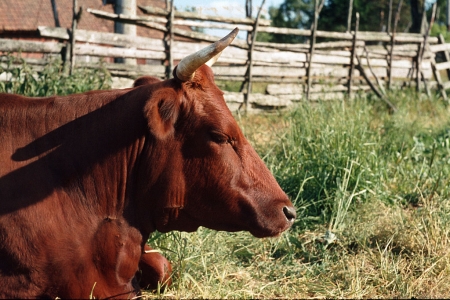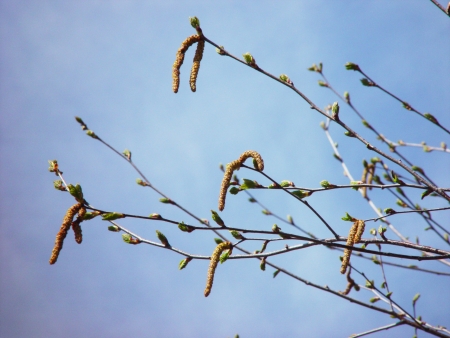For several years I was heavily allergic to birch pollen. In springtime I used to daily watch the pollen forecast on the Internet in order to be prepared to what would come. Raised birch pollen levels surely meant a running nose and bloodshot, itching eyes. By and by I became allergic to hazel and alder pollen too. There was also an unpleasant itching in the throat when I ate hazelnuts and peaches.
Before birch pollen season 2002 we read an article about birch sap in the swedish magazine "Land" (15/02). Fun with unusual things! We went out to our place in the Stockholm archipelago and directly robbed one of our big birches. Initially I tried the sap with caution, but no allergic reaction occurred. Then I had about half a liter fresh birch sap for lunch.
Some days later the birch trees started flowering in the Stockholm area. Soon very high pollen levels were reported. 2002 was a year with much pollen. But I had almost no allergic symptoms! Gradually I became suspicious of the birch sap I had tried. Therefore I had one more glass of sap when my eyes started itching after some days and thought it helped immediately. With a glass of sap a day I felt fine until our birch "went dry" (this happens when the tree bursts into leaf). Then the allergic symptoms increased, but it was much less troublesome than the years before.
I know, allergy can disappear as fast as it emerges. But with regard to the earlier development of my allergy I had expected a change for the worse rather than this dramatic improvement. Therefore I do not think that this was by sheer accident.
Instead I think that birch sap has a desensitizing effect. The sap may contain small amounts of a substance (perhaps the actual allergen), which is absorbed by the mucous membranes and this makes the body accustomed to birch. Later, when there is birch pollen in the air, the "experienced" body will not react vigorously to it.
Today pollen allergy is treated by trying to reduce the amount of pollen in the sufferer's surroundings (i.e. stay in the house, vacuum continuously, spend the holiday on a barren island without vegetation, and so on), as well as by relief of the symptoms with different medicines (antihistamines).
The only method which really tries to cure the allergy is called immunotherapy (desensitization). In this case the patient is repeatedly exposed to small amounts of pollen allergen to make the body accustomed to it, in order to avoid a severe reaction when the allergen later occurs in excess. Traditionally, immunotherapy has meant a large number of injections at short intervals, which certainly has deterred many allergic sufferers from such treatment. Nowadays there is also an oral immunotherapy method (SLIT) where the allergen is administered as a capsule or drops, hold under the tongue for some seconds and then swallowed. This method is said to work excellently. Perhaps birch sap works exactly the same way, and it may be free as well!
Of course I intensified my treatment with birch sap when facing the pollen season 2003. The improvement was even more apparent, but on the other hand the weather was changeable and pollen levels were lower than the year before. (If there is much birch pollen one year, the trees take a rest the next year in order to recover.)
I think it is important to examine if birch sap also works for other birch pollen allergy sufferers. The positive effects on public health and economics would be so great and extensive that also a research venture is justified. For a start, all who dare can make self-experiments. The method is easy, cheap and probably harmless. - Birch sap has always been regarded as food.
How to collect birch sap
Culture-historical aspects on pollen allergy -
wild speculations?
Allergies have grown into a widespread disease. The number of allergy sufferers has increased continuously since the middle of the 19th century. It is estimated that 20% of the Swedish population has allergic rhinit. Different models try to explain why. Most experts agree that it is a matter of environment and life style, not a matter of biological changes.
Traditionalists claim that air pollution, which has increased gradually since the beginning of industrialization, on one hand makes allergens more aggressive, on the other hand has a negative effect on people's resisting power against allergies. This can explain why most allergy sufferers live in cities. But when it comes to the rural population things are more complex. It turns out that disposition to allergies in farmer children is related rather to economical conditions than to dirt and air pollution. The poorer they live, with many sisters and brothers and play in the cow house, the healthier they are!
Whole nations may be compared with each other: farmer children in rich industrial countries have more allergies than farmer children in poor agricultural countries. Therefore the alternative "hygiene hypothesis" has been drawn up. According to this hypothesis we are too cleanly and "a little dirt doesn't hurt".
The different models have their devoted supporters, but there are many questions unanswered and the progress of allergies is still considered a riddle. Maybe the potential qualities of birch sap can provide the key to an alternative explanation!
In former times birch sap was commonly used by people on the whole northern hemispere. The sap was looked upon as good for health, it was an important source for sugar and minerals which people took advantage of after the winter to buck up man and beast. They said it could cure different illnesses, among other things lung diseases and the cold(!). Traditionally in the middle part of Sweden they drank "lion marrow into the bones" on 1st of May, but on such occasions the birch sap could be laced with both beer and egg ...
As people moved to the towns the handling of birch sap ceased and today only enthusiasts in the countryside keep this tradition alive. Many townspeople never have heard about birch sap or tasted it.
If birch sap has a desensitizing effect, could it then also have a protective effect against birch pollen allergy? If so, this would be an elegant explanation why birch pollen allergy was no problem in former days.
An interesting parallel regarding a protective/immunizing effect of exposing mucous membranes for small amounts of allergen is nickel allergy. Researchers in the "Nickel project" have seen indications that a dental brace (which contains nickel) may have protective effect against nickel allergy, which could result from piercing later in life. A study among all students in the cities of Umeå and Örebro in Sweden is in progress to support this suspicion with statistical methods.
But birch pollen is far from the only cause of pollen allergy. Why are so many people today allergic against e.g. pollen of grass and cereals, while this affection was unknown in the agricultural community? What did they eat then that we don't eat now?
All (?) allergenic types of pollen seem to be airborne, which means that the plants use the wind and not insects for pollination. Therefore I doubt the assertion that locally produced honey, which contains small amounts of pollen, could protect against pollen allergy. Usually honey bees do not collect airborne pollen, sallow pollen excepted.
In all times people have eaten cereal products like bread, porridge, pasta and beer. The preparation methods are today largely the same as in former times, there is no big difference. And certainly we don't eat grass, do we ... ?
 Well, indirectly we do, with milk! Cows eat grass!
Well, indirectly we do, with milk! Cows eat grass!
Substances from the food which the mother eats end up in the milk (I'll never forget the night on the maternity hospital when we had eaten pears and all babies got colic and bubble in the belly). This should be valid for cows too. In this way people could ingest small amounts of grass substances each time they drink cow's milk.
But unlike birch sap we still drink milk and cows still eat grass, why should we lack a possible protection against grass pollen allergy today?
Because we have fundamentally changed milk handling in industrial countries since the second half of the 19th century!
In the old agricultural community everybody had a cow, or at least a sheep or a goat, which could supply them with milk. This milk was given warm directly from the cow to the children and the left-overs were processed to sour milk, butter and cheese. Fresh milk's keeping qualities were very much limited.
When industrialization gathered speed and people moved to the towns small-scale milk handling was replaced by dairy service. This implied that the milk was collected and distributed, which took time. In order to get rid of dirt and awfull diseases which spread with it, the milk was boilded and soon also pasteurized. At boiling/pasteurization possible bacteria are killed, but possibly protective substances of plant origin are probably also denatured! It is known that pollen allergens are heat sensitive.
This hypothesis is supported by the circumstances that large scale dairying and allergies gathered speed almost simultaneously in the middle of the 19th century, with the United States at the head regarding both phenomenons!
That people in Sweden are less allergic than people in the USA could be due to the fact that small scale milk handling prevailed for longer time here in Sweden. Many people born in the 1940ies have spent their summer vacations in the country side and know very well how milk warm from the cow tastes. In the Baltic States this is probably still quite common.
Very simplified this could mean that the modern world got rid of tuberculosis at the cost of pollen allergies. When I was a child in the early 1950ies my mother gave me no milk at all because she did not trust the dairies. It is a long time since tuberculosis was eradicated in our cattle stock, but the milk is still pasteurized in order to increase its keeping qualities. This means that pasteurization is used to control various dirt-bacteria which grow during storage. Under these circumstances it is of course illusory (and very dangerous) to return to unpasteurized milk. It is just as illusory to return to small scale milk handling. What remains is to identify the protective substances and to ensure that sufficient amounts of them are present in the food, alternatively to use them to "vaccinate" against pollen allergy.
Imagine if it turns out that hard cheese made from unpasteurized milk (Appenzeller type) protects against grass pollen allergy! Talk about "functional food"!
You could go even further. If you enumerate all prominent allergenic plants, you will see that most of them were on the cow's menu in the old days when the cattle grazed both in woods and on pasture-land. The winter forage often contained besides hay also dried leaves from lopped off branches, e.g. birch leaves. Perhaps in the old days milk was a universal remedy against pollen allergy! The mind boggles at the thought of including animal hair allergy in the reasoning.
2003-05-15 Petra Ossowski Larsson
Translated into English 2003-11-30
About the author
Copyright 2003 Petra Ossowski Larsson

 Well, indirectly we do, with milk! Cows eat grass!
Well, indirectly we do, with milk! Cows eat grass!